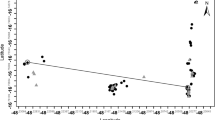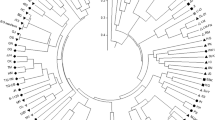Abstract
Liriodendron are ideal plants for research on mating system, systemic evolution and population genetics. Here we report the development and application of a set of simple sequence repeat (SSR) markers derived from expressed sequence tags (ESTs) of L. tulipifera. In total, 176 primer pairs were developed and yielded 132 EST-SSR markers that amplified clear SSR bands with genomic DNA of L. tulipifera. Transferability of these EST-SSR markers to related species and genera was further examined. Twelve highly informative loci screened from 132 EST-SSR markers were applied to explore the effective pollen dispersal patterns and male reproductive success of Liriodendron. A provenance trial population of Liriodendron comprised 12 L. chinense (Hemsl.) Sarg provenances and 5 L. tulipifera provenances. The four maternal trees were randomly sampled as tested maternal trees in the population. Paternities of 220 open-pollination progenies from 4 maternal trees above were potentially identified by means of paternity analysis, of which 138 progenies (accounting for 62.7%) were assigned to 49 male parents at the 95% confidence level. The cumulative exclusion probability of 12 EST-SSR loci was 98.5%. The average effective pollen dispersal distance of pollen donors ranged from 15 to 35 m, with the maximum dispersal distance of 77 m. There were obvious male reproductive success differences among individuals, ranging from 0 to 10.9%. The cumulative male reproductive success of individuals within 35 m radius around the known maternal trees reached 51.4%. Diversiform mating patterns, including selfing, intra-species mating and interspecies mating, coexisted in the occasion of open-pollination in Liriodendron.
Similar content being viewed by others
References
Austerlitz A, Dutech C, Smouse PE, Davis F, Sork VL (2007) Estimating anisotropic pollen dispersal: a case study in Quercus lobata. Heredity 99:193–204
Cardle L, Ramsey L, Milbourne D, Macaulay M, Marshall D, Waugh R (2000) Computational and experimental characterization of physically clustered simple sequence repeats in plants. Genetics 156:847–854
Caudrado A, Schwarzacher T (1998) The chromosomal organization of simple sequence repeats in wheat and rye genomes. Chromosoma 107:587–594
Cho YG, Ishii T, Temnykh S, Chen X, Lipovich L, McCouch SR, Park WD, Ayres NM, Cartinhour SW (2000) Diversity of microsatellites derived from genomic libraries and GenBank sequences in rice (Oryza sativa L.). Theor Appl Genet 100:713–722
Doyle JJ, Doyle JL (1990) Isolation of plant DNA from fresh tissue. Focus 12:13–15
Feingold S, Lloyd J, Norero N, Bonierbale M, Lorenzen J (2005) Mapping and characterization of new EST-derived microsatellites for potato (Solanum tuberosum L.). Theor Appl Genet 111:456–466
Fraser LG, Harvey CF, Crowhurst RAN, De Silva HN (2004) EST-derived microsatellites from Actinidia species and their potential for mapping. Theor Appl Genet 108:1010–1016
Gao LF, Tang JF, Li HW, Jia JZ (2003) Analysis of microsatellites in major crops assessed by computational and experimental approaches. Mol Breeding 12:245–261
Gonzalo MJ, Oliver M, Garcia-Mas J, Monfort A, Dolcet-Sanjuan R, Katzir N, Arús P, Monforte AJ (2005) Simple-sequence repeat markers used in merging linkage maps of melon (Cucumis melo L.). Theor Appl Genet 110:802–811
Han ZG, Guo WZ, Song XL, Zhang TZ (2004) Genetic mapping of EST-derived microsatellites from the diploid Gossypium arboreum in allotetraploid cotton. Mol Gen Genomics 272:308–327
He SA, Hao RM (1999) Study on the natural population dynamics and the endangering habitat of Liriodendron chinense in China. Acta Phytoecologica Sinica 23(1):87–95
Houston DB, Joehlin KA (1989) Are pollination bags needed for controlled pollination programs with Yellow-poplar? Silvae Genet 38(3–4):137–140
Jones AG, Ardren WR (2003) Method of parentage analysis in natural population. Mol Ecol 12:2511–2523
Jones ME, Shepherd M, Henry R, Delves A (2008) Pollen flow in Eucalyptus grandis determined by paternity analysis using microsatellite markers. Tree Genet Genomes 4:37–47
Jurke J, Puthiyagoda C (1995) Simple repeat DNA sequence from primates: compilation and analysis. J Mol Evol 40:120–126
Kantety RV, Rota ML, Matthews DE, Sorrells ME (2002) Data mining for simple sequence repeats in expressed sequence tags from barley, maize, rice, sorghum and wheat. Plant Mol Biol 48:501–510
Katti MV, Ranjekar PK, Gupta VS (2001) Differential distribution of simple sequence repeats in eukaryotic genome sequences. Mol Biol Evol 18:1161–1167
Kirst M, Cordeiro CM, Rezende GDSP, Grattapaglia D (2005) Power of microsatellite markers for fingerprinting and parentage analysis in Eucalyptus grandis breeding populations. J Hered 96(2):161–166
La Rota M, Kantety RV, Yu JK, Sorrells ME (2005) Nonrandom distribution and frequencies of genomic and EST-derived microsatellite markers in rice, wheat, and barley. BMC Genomics 6:23–35
Liang H, Carlson JE, Leebens-Mack JH, Wall PK, Mueller LA, Buzgo M, Landherr LL, Hu Y, DiLoreto DS, Ilut DC, Field D, Tanksley SD, Ma H, DePamphilis CW (2008) An EST database for Liriodendron tulipifera L. floral buds: the first EST resource for functional and comparative genomics in Liriodendron. Tree Genet Genomes 4(3):419–433
Liewlaksaneeyanawin C, Ritland CE, EI-Kassaby YA, Ritland K (2004) Single-copy, species-transferable microsatellite markers developed from loblolly pine ESTs. Thero Appl Genet 109:361–369
Marshall TC, Slate J, Kruuk LEB, Pemberton JM (1998) Statistical confidence for likelihood-based paternity inference in natural population. Mol Ecol 7:639–655
Meagher TR (2007) Paternity analysis in a fragmented landscape. Heredity 99:563–564
Morgante M, Hanafey M, Powell W (2002) Microsatellites are preferentially associated with non repetitive DNA in plant genomes. Nat Genet 30:194–200
Morgnte M, Olivieri AM (1993) PCR-amplified microsatellites as markers in plant genetics. Plant J 3:175–182
Rungis D, Bérubé Y, Jun Zhang, Ralph S, Ritland CE, Ellis BE, Douglas C, Bohlmann J, Ritland K (2004) Robust simple sequence repeat markers for spruce (Picea spp.) from expressed sequence tags. Theor Appl Genet 109:1283–1294
Saha MC, Mian MAR, Eujayl I, Zwonitzer JC, Wang L, May GD (2004) Tall fescue EST-SSR markers with transferability across several grass species. Theor Appl Genet 109:783–791
Sato T, Isagi Y, Sakio H, Osumi K, Goto S (2006) Effect of gene flow on spatial genetic structure in the riparian canopy tree Cercidiphyllum japonicum revealed by microsatellite analysis. Heredity 96:79–84
Schlötterer C (2001) Genealogical inference of closely related species based on microsatellites. Genet Res 78:209–212
Scott KD, Eggler P, Seaton G, Rossetto M, Ablett EM, Lee LS, Henry RJ (2000) Analysis of SSRs derived from grape ESTs. Theor Appl Genet 100:723–726
Slate J, Marshall TC, Pemberton JM (2000) A retrospective assessment of the accuracy of the paternity inference program Cervus. Mol Ecol 9:801–808
Slavov GT, Howe GT, Yakovlev I, Edwards KJ, Krutovskii KV, Tuskan GA, Carlson JE, Strauss SH, Adams WT (2004) Highly variable SSR markers in Douglas-fir: Mendelian in heritance and map locations. Theor Appl Genet 108:873–880
Sterky F, Bhalerao RR, Unneberg P, Segerman B, Nilsson P, Brunner AM, Charbonnel-Campaa L, Lindvall JJ, Tandre K, Strauss SH, Sundberg B, Gustafsson P, Uhlén M, Bhalerao RP, Nilsson O, Sandberg G, Karlsson J, Lundeberg J, Jansson S (2004) A Populus EST resource for plant functional genomics. PNAS 38:13951–13956
Tautz D (1989) Hypervariability of simple sequences as general source for polymorphic DNA markers. Nucl Acids Res 17:6463–6472
Temnykh S, DeClerck G, Lukashova A, Lipovich L, Cartinhour S, McCouch S (2001) Computational and experimental analysis of microsatellites in rice (Oryza sativa L.): frequency, length variation, transposon associations and genetic marker potential. Genome Res 11:1441–1452
Toth G, Gaspari Z, Jurke J (2000) Microsatellites in different eukaryotic genomes: survey and analysis. Genome Res 10:967–981
Tuskan GA, Gunter LE, Yang ZK, Yin TM, Sewell MM, DiFazio SP (2004) Characterization of microsatellites revealed by genomic sequencing of Populus trichocarpa. Can J For Res 34:85–93
Varshney RK, Graner A, Sorrells ME (2005) Genic microsatellite markers in plants: features and applications. Trends Biotechnol 23:48–55
Wang ZR (2005) Utilization and species hybridization in Liriodendron, Chinese Forestry Press, Beijing
Wang Y, Luo J, Xue X, Korpelainen H, Li C (2005) Diversity of microsatellite markers in the populations of Picea asperata originating from the mountain of China. Plant Sci 168:707–714
Xu M, Li HG, Zhang B (2006) Fifteen polymorphic simple sequence repeat markers from expressed sequence tags of Liriodendron tulipifera. Mol Ecol Notes 6:728–730
Yao X, Zhang J, Ye Q, Huang H (2008) Characterization of 14 novel microsatellite loci in the endangered Liriodendron chinense (Magnoliaceae) and cross-species amplification in closely related taxa. Conserv Genet 9(2):483–485
Yu JK, Rota ML, Kantety RV, Sorrells ME (2004) EST derived SSR markers for comparative mapping in wheat and rice. Mol Gen Genomics 271:742–751
Zhang DY, Jiang XH (2001) Mating system evolution, resource allocation, and genetic diversity in plants. Acta Phytoecologica Sinica 25(2):130–143
Acknowledgments
This study was financially supported by the National Natural Science Foundation of China (30771748, 30972391).
Author information
Authors and Affiliations
Corresponding author
Rights and permissions
About this article
Cite this article
Xu, M., Sun, Y. & Li, H. EST-SSRs development and paternity analysis for Liriodendron spp. New Forests 40, 361–382 (2010). https://doi.org/10.1007/s11056-010-9205-0
Received:
Accepted:
Published:
Issue Date:
DOI: https://doi.org/10.1007/s11056-010-9205-0




